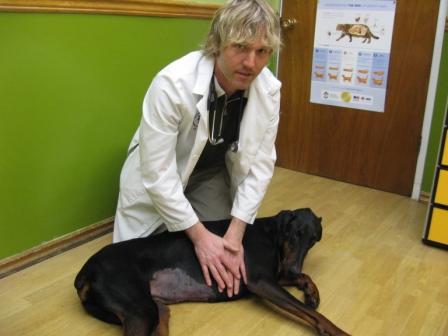What To Do If Your Dog Or Cat Has A Fever
If your dog or cat has a fever, you are probably very concerned, and have a number of questions. In this article I’ll reveal to you the most common causes of fever in cats and dogs, plus the signs to be aware of. Then I’ll go into the top 5 remedies that you can immediately use to help your pet’s fever, and bring the temperature down fast.
Fever is defined as a higher than normal body temperature in your dog or cat; in veterinary terms this is called pyrexia. A normal dog’s temperature is 101 F (38.0 C), a normal cat’s temperature is 102 F (38.5 C). Taking your pet’s temperature involves placing a thermometer in their rectum. If your pet has a temperature of 103.5 F (39.5 C) or more, they have a fever.
A fever is usually caused by a bacterial or viral infection. Having a high temperature makes it more difficult for bugs to grow in the body. The problem with a fever in pets is that they will often stop drinking; dehydration then becomes the primary concern. Your pet usually will have a fever in response to something going on in their body. The most common cause, I find, is bite wounds. Search your dog or cat well for punctures.
Signs and symptoms of fever in dogs and cats include the primary one of having and above normal body temperature. Your pet may have a decreased appetite and lower energy. Your dog or cat’s ears can be hot to the touch and they may pant excessively in the house. Some pets will shiver, others can have an elevated heart rate. All much the same signs that people have with a fever.
If you suspect that your dog or cat has a fever, what should you do? Firstly start with the obvious, and take their temperature, determining if it is elevated. If the temperature is 103.5 F (39.5 C) or more, then they have a fever. If a fever persists for more than 24 hours, and your pet is not drinking, then call your veterinarian. If they are still drinking, or in the interim before going to your veterinarian, here are some additional remedies and supportive care that you can consider.
Keep your dog and cat hydrated. Offer plenty of fresh water in different spots around the house. If your pet refuses to drink, use an eyedropper or turkey baster to squirt water into the side of its mouth. Minerals become depleted when your pet is dehydrated; for an added boost, add Pedialyte, an electrolyte solution available from the pharmacy. Some pets prefer chicken or beef broth, or tuna juice; give them whatever works.
A cool compress is a very safe, easy and inexpensive remedy to consider. f your pet will tolerate it, apply a cold cloth to her belly. The exposed skin will result in some fairly rapid cooling, making her feel a little better.
There is a conventional medication that you can use for your dogs. Aspirin can be safely used in dogs to bring down a fever; never use it in cats. The Aspirin dose is one 325 mg tablet per 40 lbs of body weight given every 12 hours.
Echinacea and Sage are effective antimicrobial herbs. You can give a combined herbal formula of 1 drop per pound twice daily of the tincture. Another option is to use commercially prepared products such as Echinamide. The Dose is 0.1 ml per 10 lbs every 8 hours.
There are a number of homeopathic remedies that you can consider for fever, the more common ones being Belladona 30C and Ferrum Phosphoricum 30C. These can be given every 1-2 hours with a typical dose being 1 capsule per 10-20lbs of body weight.
You should now be much more aware of the signs and symptoms of fever in dogs and cats; more importantly you should be comfortable taking your pet’s temperature seeing if is elevated. Fever is a response to disease; common causes include bite wounds and abscess. If your pet is still drinking, then you can use some of the discussed home remedies, such as: cold compresses, the herb Echinacea, and the homeopathic Ferrum phosphoricum.
Heal Your Pet At Home!
Best Wishes,
Dr Andrew Jones, DVM
P.S. If you liked this article, then I encourage you to sign up for my newsletter where you’ll get my Free Book and Videos on How To Heal Your Pets At Home with my TOP Natural Remedies.
The big key to having a healthy dog or cat is also knowing WHAT to do to prevent common dog and cat diseases in the first place.
Such as knowing what to feed, what vaccines to give and avoid, and what natural treatments you can use to treat chronic illnesses such as allergies.
I’ll show you precisely what you can do immediately to both prevent and treat diseases in your dog or cat; you’ll be using my holistic tips and remedies with simple easy to follow instructions.
Sound interesting?
Enter your name and email address below and click “Sign Me Up” to get free updates:

Um, I may be wrong because this is a big dog that you are using in the demonstration, but shouldn’t the dog in the photo of you doing CPR be laying on their other side. I can feel the heartbeat on both of our dogs (large and small) best on the left side.